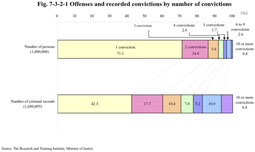| Previous Next Index Image Index Year Selection | |
|
|
Fig. 7-3-2-1 reveals the number of offenders and cases by total number of convictions in the One Million Non-Repeat and Repeat Offenders' Recorded Convictions.
Fig. 7-3-2-1 Offenses and recorded convictions by number of convictions In comparison to the number of non-repeat offenders, who comprised 70.1% of the entire number of offenders, repeat offenders accounted for only 28.9%. However, the number of criminal offenses committed by non-repeat offenders out of the total number of recorded offenses accounted for 42.3% of the total number of criminal offenses, with the number of criminal offenses by repeat offenders accounting for 57.7%, thus indicating that the majority of offenses, around 60% in fact, were committed by repeat offenders who only account for about 30% of the total number of offenders, and wherein lies the rationale as to why countermeasures against repeat offenders are very important in criminal justice policy.In addition, it was found that the more recorded convictions an offender has the more he/she contributes to the increase in number of offenses. Those with ten or more recorded convictions, hereinafter referred to as “multiple repeat offenders,” in particular, who only number 8,398 or 0.8% of the entire one million offenders, were actually responsible for 108,201 (6.4%) of the recorded convictions, revealing that the majority of the crimes were caused by a few offenders. The same trend has been confirmed in various evidence-based research carried out in Europe and the United States (For example, according to the Home Office of the United Kingdom, multiple repeat offenders accounting for 0.5% of offenders were responsible for 9% of the crimes). Based on these facts, and no matter the type of multiple-repeat offender, a repeat offense originates in a second offense being committed, and hence effective measures need to be implemented that prevent the commission of that second offense. In this chapter, the process with proceeding from the first crime to the second was analyzed from various aspects, and measures to prevent an offender who has committed a first offense from committing a second offense are considered (see Section 4, subsection 1, 2 and 5). Along with this, in regard to repeat offenders whose total number of convictions amount to three or more, as specific countermeasures to prevent them from committing multiple offenses need to be established, detailed analysis of their characteristics was made (see Section 4, subsection 2 and 5). Exploring the major offenses to which countermeasures are needed, an attempt was made to determine the number of accumulated recorded convictions by type of offense. Fig. 7-3-2-2 shows the percent distribution of number of recorded cases by frequency of conviction and type of offense out of the One Million Non-Repeat and Repeat Offenders' Recorded Convictions. Fig. 7-3-2-2 Percent distribution of recorded convictions by frequency of conviction and type of offence Disregarding the number of convictions, the most prevalent offenses were injury, theft, assault, and violations of the Stimulants Control Act. Particularly after the third conviction, the order of the most prevalent crimes was theft, injury, and violations of the Stimulants Control Act. In this chapter, therefore, the circumstances and attributes of repeat offenders shall be reviewed with a special focus on the most common offenses (see Section 4, 1 through 4). |

